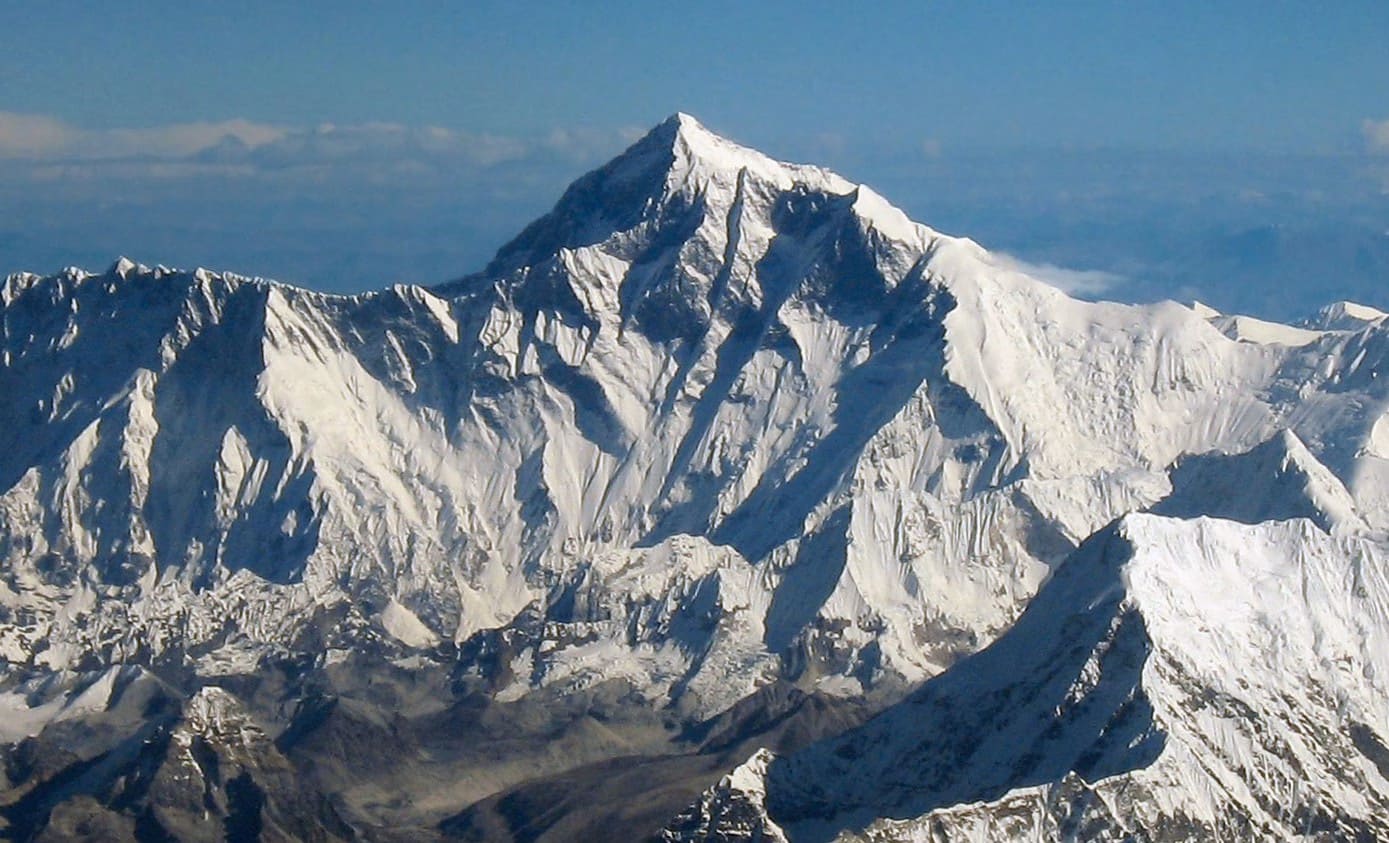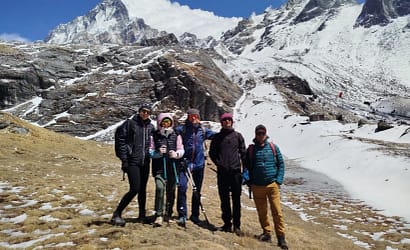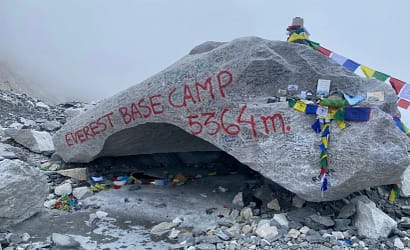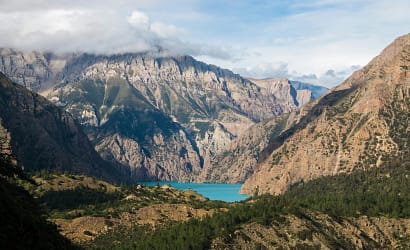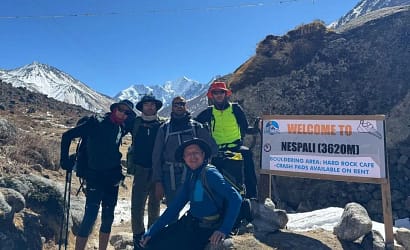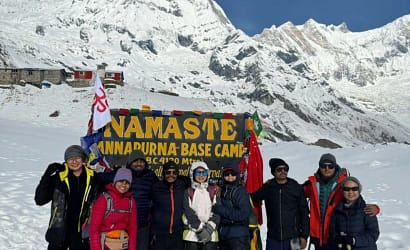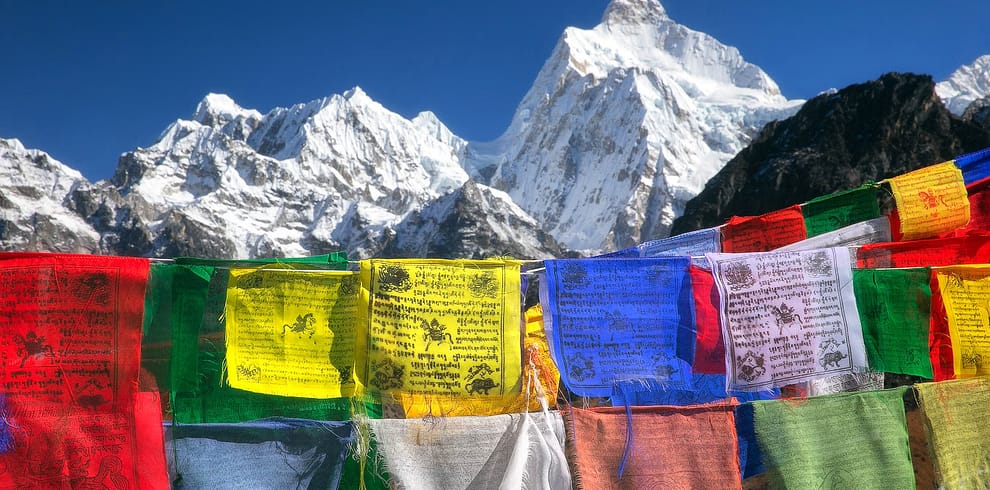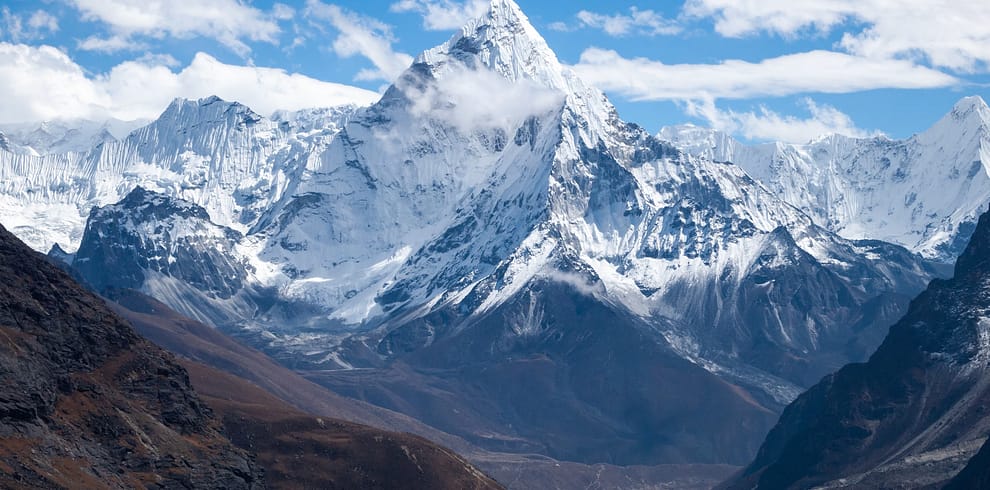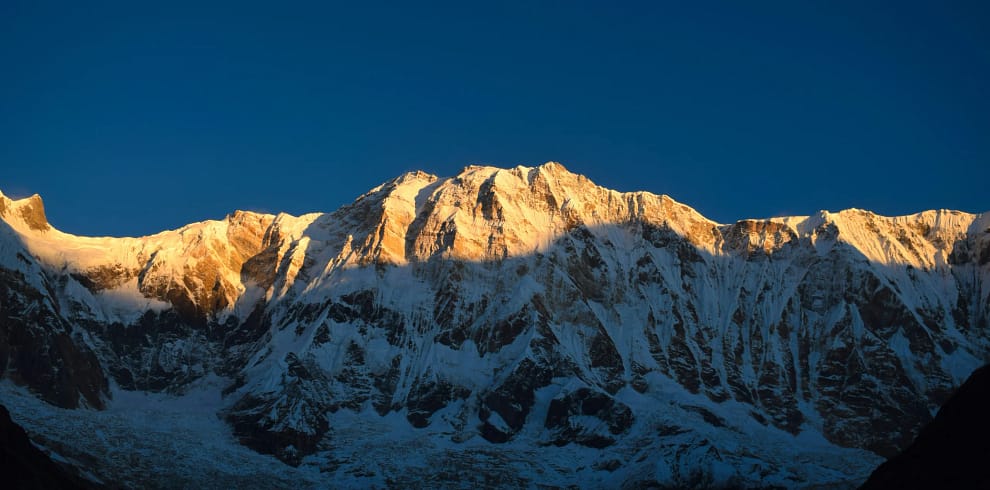-
Hotel + Lodge + Camping
-
Kathmandu
-
Spring
-
8848M
-
Breakfast, Lunch & Dinner
-
2
-
5-7 Hours
-
Avaliable
The Everest Expedition is an audacious quest that tests one’s spirit and strength at the hands of the Himalayas. Mount Everest, located within the stunning Sagarmatha National Park, stands as the tallest peak in the world at 8,848 meters. Recognized as a UNESCO World Heritage Site, this region offers breathtaking beauty and remarkable biodiversity. Our well-experienced Sherpa team guarantees safe passage on every step that is taken; alleyways of deep knowledge of mountains are accompanied by unmatched experience and professionalism with high-altitude risks. From the dirty streets of Kathmandu to the icy trails of Everest, every day you encounter is a spark of the desire to get to the top.
With a glorious flight into Lukla, the itinerary kicks off with the adventure, followed by a trek through Sherpa villages, monasteries, and scenic Himalayan landscapes. Each of the camps along the Everest Base Camp route is painstakingly selected to aid proper rest and gradual altitude acclimatization. Camps at Base Camp are facilitated to perform technical training and gear checks for climbers with licensed high-altitude expedition leaders. Climbers would further perform acclimatization rotations to higher camps in readiness for the summit. On summit day, all climbers would depart in the darkness prior to dawn, ensuring they would be crossing the South Col and onto the summit of the world.
The climb is just half the story; the other half is safely descending and getting back to Kathmandu, resting, partying, and reminiscing over the trip. The package covers permits and logistics, meals, professional guides, medical support, and emergency evacuation coverage for the Everest Expedition. Blaze Mountain fosters a life-altering experience based on trust, adventure, and Himalayan excellence. Walk with us, make legends of your dream, and climb Everest with expert hands all the way.
Trek Note: Everest Expedition
Trek Duration: 60 Days
Max Elevation: 8,848.86m
Trek Grade: Extremely Strenuous & Highly Technical
Best Season: Spring (April-May)
Accommodation: Teahouses & Camping
Permits Required: TIMS, Sagarmatha National Park Permit, Climbing Permit, Liaison Officer
Everest: The final mountaineering challenge and the worldwide attraction for climbers on top of the planet. The journey from Kathmandu will involve detailed briefings, gear checks, and the necessary arrangements for permits. After that, they will take a flight into Lukla, and the trek through the legendary Khumbu will begin. The trail takes you through Namche Bazaar, Tengboche, Dingboche, and Gorak Shep before reaching Everest Base Camp set at 5,364 m.
At Base Camp, climbers will undergo sheer acclimatization and technical training, including rotation climbs to higher camps. These rotations allow one’s body to acclimatize to the very high altitude and the arduous demand placed on it when making the final push to the summit. Then it begins, the historically classic South Col descent, including the establishment of Camp I, Camp II, and Camp III, along with the Khumbu Icefall, Lhotse Face, and the Hillary Step.
Summit day is an extraordinary test of conditioning, courage, and will, as climbers head to the top of the world just before dawn. The initial descent follows the same trail, with time for rest and safety checks before the final return to Kathmandu. The Everest Expedition calls for good physical condition, prior high-altitude experience, and strong mental fortitude. Blaze Mountain has arranged for a fully supported expedition that includes Sherpas, high-altitude porters, emergency evacuation plans, and complete logistics. Safety, professionalism, and an unforgettable experience leading you to Earth’s most iconic summit are of utmost importance.
Additional Information:
You can access full details regarding the Everest Expedition from our website. If you need any extra information or extra service, feel free to contact us. To meet our agent, please follow the link, and/or if you want to talk to us directly, you can call our office at +977-1-4522505.To learn more about global mountaineering ethics and practices, you may also explore resources from the International Climbing and Mountaineering Federation (UIAA).
Overview
Everest is the highest mountain in the world, with a peak at 8848 meters above sea level. Mount Everest reigns over the mountains all over the world. The Everest Expedition 2015, which is aimed at summiting Mount Everest, is seen as one of the most respectable and glorious adventure undertakings and is also regarded as the dream worth dying for. Mt. Everest is located in the Mahalangur range section of the great Himalayas, whose summit ridge marks the border between Nepal and China.
Nepali name of Mt. Everest is Sagarmatha, Tibetan name of Mount Everest is ‘Qomolungma.’ Mt. Everest got its name after Sir George Everest, head of the Survey of India from 1823 to 1843. With the opening of Nepal to foreigners in 1951, many tried for the Everest summit, but it was first scaled by New Zealander Sir Edmund Hilary and Nepali Sherpa Tenzing Norgay via the south col. A typical expedition of Everest lasts for about 2 months. Everest Trail Adventure offers expeditions to Everest via either the South Col route from Nepal or the North from Tibet.
In April and May, the season has maximum attempts to reach the summit before the summer monsoon season. Though added snow deposited during the monsoon makes climbing even more difficult, the attempts are also sometimes made after the monsoon in September and October. The payoff from the expedition is unexplainable; the feeling of accomplishment is for a lifetime. The reward of holding the beautiful mountain in your eyes is needless to explain.
The member of the expedition group should have extensive training on climbing. Generally two years of effortful training and experience in mountain climbing are necessary to triumph over Mt. Everest. Trekking in the mountains has designed the Everest expedition in order to ensure a 100% success rate. The highly experienced and trained guides will be there to guide you through this journey. It is a very risky undertaking, so you need to be strong both physically and psychologically. Proper acclimatization is necessary; hence, you will spend a notable amount of time in various camps before attempting the summit. Blaze Mountain Adventure wants to assure you the best possible assistance to turn your Everest dream into reality. If you want to book or know further details regarding the Everest expedition 2015, feel free to contact Blaze Mountain now. It’s time you realized your dream!
Specialty of Everest Expedition
Climbers are tested to the maximum on the highest peak in the world during the renowned Everest Expedition. Everest continues to be the jewel in the crown of Himalayan adventures because of its challenging weather, legendary climbing routes, and unparalleled views. These are the main areas of expertise that set this trip apart.
- World’s Highest Everest-—Climbing It
The ultimate peak for mountaineers worldwide stands 8,848.86m tall: that of summiting Mount Everest. Standing atop the roof of the world, one experiences an extremely deep level of achievement coupled with raw awe. It means battling extreme altitudes, navigating technical icefalls, and sheer determination. It’s one of those challenges that ultimately tests your physical strength, mental endurance, and high-altitude climbing skills. Few experiences can rival the feeling of watching the sunrise from the top of the world. - Fabled Climbing Route and Legendary History
The expedition is on the legendary South Col route, which was used by Sir Edmund Hillary and Tenzing Norgay in 1953. This route inherited immeasurable historic value and is a link with the heritage of pioneering Himalayan climbers. During the course, climbers will pass through Khumbu Icefall, Lhotse Face, and Hillary Step—each a symbol of Everest’s technical prestige. Each stage reflects a chapter in mountaineering history, adding spiritual depth to the journey. - Exposure to Local Culture in the Khumbu Region
It is a trek in itself to Base Camp-from Sherpa villages, ancient monasteries, and spiritual sites. Namche Bazaar and Tengboche are two great examples of places where one can get a feel for Sherpa tradition and Buddhist culture. The sacred energy along the walk was created by that cultural richness, open-hearted hospitality, and whispering prayers through fluttering flags. - Severe High Altitude Climbing for Experienced Mountaineers
The true test of a great climber is Everest. The expedition requires a series of high camps to be established and must contend with extreme alpine conditions. It encompasses fixed rope systems, oxygen support, and intense physical readiness. For the climbers who have already climbed above 6000 meters, measurement is quite important for taking them higher on their top stage. - All-out Logistics with World Class Support
In fact, Blaze Mountain offers unmatched expedition support: professional guides, experienced Sherpas, high-altitude porters, and round-the-clock medical backup at base camps well equipped with communication systems, kitchen tents, and rest facilities. Safety is prioritized because of the well-structured itinerary and emergency evacuation plans, as well as daily health monitoring. You are never alone with us at the mountain.
The Everest Expedition is more than just a climb; it’s a trip through the pinnacles of human tenacity, heritage, and difficulty. You will have an amazing journey to the top of the globe with Blaze Mountain.
Is the Everest Expedition Right for Trekkers and Climbers?
- The Everest Expedition is a high-altitude and highly technical climb meant only for experienced mountaineers.
- It is not suitable for beginner trekkers or those without prior alpine climbing experience.
- Climbers should have previous experience on peaks above 6,000 meters with exposure to extreme altitudes.
- Knowledge of fixed ropes, ice axes, crampons, and glacier travel is essential for safety and success.
- Participants must be in excellent physical condition and capable of enduring long periods in cold, low-oxygen environments.
- Strong mental resilience is crucial for facing the physical and emotional challenges of the expedition.
- This expedition includes crossing dangerous terrain such as the Khumbu Icefall and the Lhotse Face.
- Proper acclimatization and prior experience with high-altitude trekking or expeditions are mandatory.
- Those with serious medical conditions or without prior training are advised not to attempt this expedition.
- For less experienced adventurers, the Everest Base Camp Trek is a safer and equally rewarding alternative.
- Blaze Mountain provides expert guidance to help assess your readiness and prepare you for the challenge.
Who Should Join the Everest Expedition?
- Experienced trekkers who have completed high-altitude treks and want to transition into mountaineering.
- Intermediate to advanced climbers looking for a 7,000-meter peak before attempting 8,000-meter summits.
- Adventure seekers who enjoy remote, off-the-beaten-path Himalayan expeditions.
- Physically fit individuals with a strong mindset and the ability to endure long, challenging climbs.
The Everest Expedition is an incredible experience that will push your boundaries and reward you with breathtaking Himalayan vistas and a genuine sense of success if you possess the willpower, physical stamina, and enthusiasm for high-altitude adventure. Climbers who are prepared to take on the challenge can participate in this adventure since Blaze Mountain guarantees a safe and well-supported trek.
Best Season for Everest Expedition
Choosing the right season for your Everest expedition is key to ensuring both your safety and success. Here’s a breakdown of each season to help you understand the conditions and make an informed decision.
- Spring (March to May)
Spring is probably the most popular time to climb Mount Everest. In these months of the year, generally, the weather remains rather stable, temperatures turn into moderates for high altitude climbing, and days get longer and generally bright blue, with stunning views of surrounding peaks. The Khumbu region is then followed with some of the brilliant and vibrant rhododendron blooms and beautiful landscapes. Most of the expeditions are therefore booked within this period with the routes being so well established with fixed ropes and fairly dependable infrastructure, making it the best time for summit attempts. - Summer/Monsoon (June to August)
Mount Everest expeditions are poorly timed with the height of the summer monsoon season when continuous heavy showers and the weather are entirely unpredictable. The trails leading to Base Camp and the high-altitude areas are extremely slippery and dangerous, while the lower regions suffer from landslides and very arduous trekking conditions. In addition to this, the danger of avalanches increases due to the height. Visibility at higher altitudes is severely affected by incessant rains and clouding. Because of these extreme conditions, most expeditions avoid this time, and few climbers would attempt to summit during the monsoon season. - Autumn (September to November)
For an Everest expedition, autumn also ranks second on the growing list of choices. It is generally dry and stable, skies being clear and temperatures crisp. Though colder than spring, it has the advantage over that season in that there is less rain and the chances of avalanches are lower, making it a better option in terms of safety for ascents to the summit. Generally, the trekking routes are dry, and the surrounding views remain beautiful, with Everest and the neighboring peaks very clearly visible. Fewer climbers are observed around the autumn months as compared to the spring season. Nevertheless, it can still be a rewarding experience with fewer crowds and great visibility. - Winter (December to February)
The winter season in this region of Everest is extremely cold and has poor conditions for climbing; hence it is the least favorable season for summiting Everest. In high places, temperatures can fall well below freezing. Most importantly, the weather becomes very unpredictable due to snowstorms and blizzards, which make climbing rather difficult. Short days and thinner air compound the already difficult climbing situation. Most summit expeditions are thus avoided at this time of year, although a handful of extremely experienced climbers may make the attempt during these exceptionally harsh conditions after extensive training and evaluation of risks.
Weather Table of Everest According to Altitudes:
Reliable weather forecasts are crucial for a safe ascent. We recommend checking the detailed Mount Everest weather forecast before and during your expedition.
| Altitude | Day Temperature (°C) | Night Temperature (°C) | Weather Conditions |
|---|---|---|---|
| 1,000m – 2,500m | 20°C to 25°C | 10°C to 15°C | Warm during the day, cooler nights, clear skies with occasional clouds. |
| 2,500m – 4,500m | 15°C to 10°C | 5°C to -5°C | Milder temperatures with some light rainfall, colder nights with cool winds. |
| 4,500m – 6,500m | 5°C to 0°C | -10°C to -15°C | Cold with occasional snow, winds begin to pick up in higher elevations. |
| 6,500m – 8,000m | -5°C to -10°C | -20°C to -30°C | Harsh winds, extreme cold, snowstorms more frequent. |
| 8,000m – 8,848.86m | -20°C to -30°C | -40°C to -60°C | Extreme cold, powerful winds, very low oxygen, blizzards common. |
Local Culture and Tradition Around Everest
Buddhism in Tibet would naturally greatly affect the lives and spiritual practices of the local peoples of the area surrounding Everest. Monasteries and stupas dot the landscape in worshipful places, quite often also serving as prayer grounds. Swinging wildly in the winds, prayer flags are a cry for blessings-great health and safe journeys. High altitude and well known, one of the central religious sites of the region is none other than the Tengboche Monastery; it offers trekkers and climbers opportunities to pause for self-reflection and spiritual comfort before setting off toward Everest again.
Lhosar-Tibetan New Year-is far and away the most important holiday. It is time for merrymaking, singing, dancing, and feasting. The celebration marks the first day of the lunar calendar new year. Other important celebrations include Buddha Jayanti, honoring the founder of Buddhism, and Chhewar, a coming-of-age ceremony for young boys. These festivals shed light on the cultural heritage of the Everest region; they bring together the sense of community and share joy with the local people.
Food & Accommodation Facilities During Everest Expedition
By providing a mix of native and Western food and basic yet decent lodging, the Everest Expedition makes sure that climbers are fed and comfortable throughout their trip. The facilities are simple yet offer the required warmth and comfort because of the region’s high altitude and remoteness. What to anticipate is as follows:
Food Options
During the Everest Expedition, trekkers and climbers have access to a variety of local and Western food options to maintain energy and stamina.
- Local Food: The diet generally consists of traditional Sherpa dishes like Dal Bhat (rice and lentil soup), Sherpa stew, and Tibetan bread with curry. These are carbohydrate, protein, and vegetable-rich foods that are required for long walking days, especially at high altitudes.
- Western Food: As a relief from the local food, Western food such as pancakes, sandwiches, pasta, and fried potatoes can be enjoyed at most of the lodges and tea houses along the trail. These foods provide instant energy and thus are a trekker’s delight.
- Refreshments & Beverages: Chocolates, biscuits, and dried fruits are readily available along the route. Tea, coffee, and hot chocolate are also provided for the trekkers, which are perfect for both hydration and warmth, especially after a chilly day of trekking.
Accommodation Options
Accommodation during the Everest Expedition is basic but ensures climbers have a comfortable and restful stay after a day of trekking.
- Tea Houses & Lodges: The primary accommodation facility along the Everest route is tea houses and lodges. Here, one can have plain but cozy rooms, either sharing or having their own bathrooms. Local Sherpa hosts offer warm hospitality, keeping the place homely, and this makes it easy for climbers to relax.
- Accommodation at Higher Altitudes: As one goes higher in altitude, the accommodations become simpler. At these altitudes, rooms are cold, and facilities are limited, with shared toilets and washrooms. In spite of these circumstances, the hospitality of the Sherpas and the simple comfort of these accommodations make them perfect for resting.
- Camping: At some sections of the trek at higher elevations, camping would be necessary for acclimatization. Climbers will spend the night in tents, surrounded by the serene environment of the Himalayas. Camping allows trekkers to rest and acclimatize before attempting the summit.
The Everest Expedition ensures that climbers are well-fed, comfortable, and rested throughout their journey with a mix of traditional and Western food, and basic, hospitable accommodation options.
Necessary Gear for the Everest Expedition:
Proper gear is essential to ensure safety, comfort, and success on the Everest Expedition. The gear must be suitable for both the lower altitudes and the challenging high-altitude conditions of this trek.
Clothing:
- Base layers (thermal tops and bottoms): Essential for regulating body temperature by wicking away moisture and providing warmth.
- Fleece jacket or down jacket: These layers will keep you insulated and protected from cold weather, especially in high-altitude conditions.
- Waterproof and windproof outer layer: A durable jacket will protect against snow, rain, and strong winds, which are common at higher altitudes.
- Trekking pants (water-resistant): Water-resistant pants will ensure your legs stay dry and comfortable while trekking through varied terrain.
- Insulated gloves and warm hat: Cold hands and head can lead to discomfort and fatigue, so high-quality gloves and a hat are essential for warmth.
- Thermal socks and mountaineering boots (insulated): Thick, moisture-wicking socks combined with sturdy, insulated boots will protect your feet from the cold and ensure comfort on long days.
Climbing Equipment:
- Crampons: These will provide the necessary traction on icy surfaces, preventing slippage when navigating steep or frozen terrain.
- Ice axe: Vital for stability and support on ice and snow-covered slopes, offering extra grip when climbing.
- Harness and ropes: For safety during the climb, ensuring secure movement on vertical sections or ice-covered terrain.
- Climbing helmet: A must-have to protect your head from falling rocks and ice, especially on the summit push and other technical sections of the climb.
Camping and Sleeping:
- Sleeping bag (rated for extreme cold): A high-quality sleeping bag is necessary for warmth during cold nights at higher altitudes, ensuring you get proper rest.
- Sleeping pad for insulation: The sleeping pad provides both comfort and insulation from the cold ground, which is essential for a restful sleep.
- Tent for high-altitude camps: A weather-resistant, insulated tent is necessary to withstand high-altitude conditions, offering shelter from strong winds and snow.
- Headlamp with extra batteries: Essential for navigating the camp area and for any night-time treks. Ensure the headlamp is bright and reliable.
Health & Safety:
- First aid kit: A comprehensive first aid kit, including essentials like bandages, antiseptic, and pain relievers, is crucial for addressing injuries or emergencies on the trail.
- Altitude sickness medication: To prevent and manage symptoms of altitude sickness, carry recommended medications and always monitor your condition.
- Water purification system: Clean drinking water is not always available, so a purification system (tablets, filters, or purifiers) is essential for safe hydration.
- Sunscreen and lip balm: High-altitude sun exposure is intense, and protecting your skin from harmful UV rays is critical, so carry sunscreen and lip balm with SPF.
- Personal hygiene items: Items like biodegradable soap, wet wipes, and hand sanitizer will help maintain hygiene on the trail, where water sources may be limited.
Miscellaneous:
- Trekking poles: Essential for maintaining balance and reducing strain on the knees while trekking across uneven, rocky terrain.
- Sunglasses or goggles: Protect your eyes from harmful UV rays and snow glare at higher altitudes with high-quality sunglasses or goggles.
- Camera and power bank: Capture the incredible scenery and ensure your camera stays charged to document the journey.
- Backpack with rain cover: A reliable backpack will hold all your gear, and a rain cover will protect your equipment during sudden downpours or snowstorms.
Why Choose Everest Expedition with Blaze Mountain?
Choosing Blaze Mountain for your Everest Expedition is a decision that gifts your adventure to a team that cares for safety and honesty beyond any other value. Experienced local Sherpa guides lead our expeditions, guides who have been navigating the labyrinth of the Himalayas for all their lives. Such cultural ties, knowledge of the high-altitude terrain, and technical climbing skills mean that your ascent will be secure and well-guided in equal measure. Right from the start, our team supports you with all logistics permits, gear checks, and travel arrangements that leave you to think about the adventure that lies ahead.
What we offer uniquely at Blaze Mountain is our commitment to a well-structured, flexible, and personalized climbing experience. We design itineraries that allow enough time for acclimatization, with contingency days to cope with changing mountain conditions. Along the way, climbers are sustained by a proper mix of local hospitality, hearty meals, and comfortable accommodations that keep the mood uplifted and energy levels high. With a professional support crew, high-altitude porters, medical preparedness, and emergency evacuation plans, we guarantee that your Everest Expedition will be a thrilling experience but also a safe, caring, and everlasting memory.
Trip Highlights: Everest Expedition
- Experience the thrill of summiting Mount Everest, the highest peak on Earth at 8,848.86 meters above sea level.
- Trek through the legendary Everest Base Camp route, passing vibrant Sherpa villages and dramatic alpine landscapes.
- Climb under the leadership of expert Sherpa guides with years of high-altitude mountaineering experience.
- Climb under the leadership of expert Sherpa guides with years of high-altitude mountaineering experience.
- Witness breathtaking views of iconic Himalayan peaks including Lhotse, Nuptse, Ama Dablam, and Makalu.
- Immerse yourself in the local culture by visiting monasteries and learning about the spiritual life of the Khumbu region.
- Stay safe with comprehensive expedition logistics, including oxygen, satellite communication, and emergency rescue planning.
- Live the true base camp experience among global climbers, supported by a fully equipped camp and experienced staff.
- Receive full pre-expedition support with gear recommendations, training tips, and travel coordination.
- Contribute to sustainable tourism practices that respect local communities and protect the natural environment.

